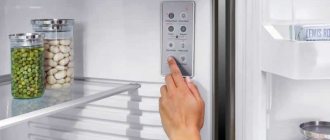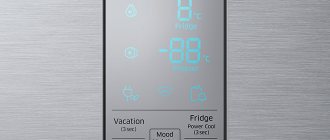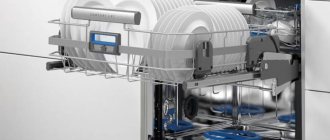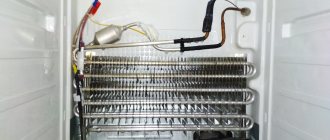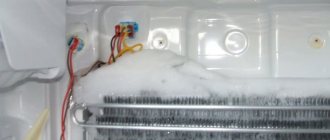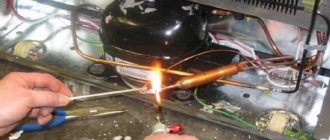The role of the fan in the No Frost refrigerator
In the cooling chamber located behind the inner wall of the refrigerator or freezer, the process of removing heat and moisture from the cooling zones occurs. An evaporator, with a defrosting element and a fan are placed in a compact space. At the moment of rotation, the fan blades create a vacuum and draw in gas.
Warm air from the refrigerator enters the chamber, is directed by a fan through the gaps between the evaporator tubes under pressure, cools, and leaves moisture on the radiator tubes. The gas is blown back through the chamber slits. Circulation occurs.
Manufacturers choose different flow directions. Cold air can be supplied from the ceiling, from the sides, to each shelf. A special case is two independent convection cooling circuits with 2 fans, thermostats for the refrigerator and freezer compartments.
While the evaporator is cooled by freon supplied by the compressor, the wind blower rotates, and the products are cooled. The propeller stops, the automation turns on the heating element, the ice thaws and goes through the drainage hole into a special tray. If the fan stops abnormally, the evaporator will be cold, but the chambers will become warm, and the compressor will work in vain.
Fans in the refrigerator are used not only with No Frost. A refrigerator with regular freezing and manual ice removal, which has an accelerated cooling function, also has a fan. It works for a short time, pumping cold to quickly cool a new portion of food. There are fans for cooling the refrigerator, cooling compressors and condensers in large cabinets. They have one purpose - to reduce the temperature in the unit.
Tips for choosing, rating
To simplify the task of choosing a No Frost refrigerator, you can use the rating below of the most popular models in 2020. The rating includes units with No Frost systems in either only one or both chambers. The rating also indicates their advantages, disadvantages and general technical characteristics.
Indesit ITF 118 W
The unit, with a standard width of 59.5 cm and a height of 185 cm, is equipped with built-in door handles and the Total No Frost system.
The freezer compartment with a capacity of 75 liters is located at the bottom. Transparent lids are available on all 3 drawers.
The volume of the refrigerator compartment is 223 liters, it is equipped with 4 shelves, a lighting unit, 2 containers for vegetables and fruits, and 4 wide door trays.
Advantages:
- relatively low price;
- the presence of an external electronic control display;
- an incandescent lamp is used as illumination;
- economical energy consumption (class A);
- Push Cool fast freezing mode available.
Flaws:
- not the quietest (noise level 40 dB);
- single-circuit cooling system.
Website of the Indesit specialized store: https://www.indesit.ru/
Atlant XM 4426-009ND
A refrigeration appliance from a Belarusian manufacturer with a Full No Frost system has convenient built-in handles. Height is 208.6 cm, width 62.5 cm.
The volume of the freezer, which is located below, is 85 liters. There is an ice tray and 3 transparent drawers.
The 247 liter refrigerator compartment has 5 shelves and 2 vegetable containers. The door is equipped with an audible alarm that goes off after 60 minutes of being in the unlocked position.
Pros:
- relatively low cost;
- economical energy consumption class A;
- external electronic display;
- the presence of “Super Freezing”, “Super Cooling”, “Cooling Drinks”, “Vacation” modes;
- The unit is equipped with a multi-flow air supply system.
Flaws:
- poor lighting (15-watt lamp);
- noise level 43 dB.
Website of the Atlant specialized store: https://atlant.by
LG DoorCooling+ GA-B509 CMDZ
The classic-sized refrigerator, 60 cm wide and 203 cm high, has a spacious freezer compartment with a capacity of 107 liters and a refrigerator compartment with a capacity of 277 liters.
The refrigerator compartment is equipped with a Multi Flow multi-flow system and a DoorCooling+ ceiling panel. The chamber has 4 shelves, one of which is for wine and one is foldable. There are also 2 freshness zones for fruits, fish, meat and vegetables.
Advantages:
- economical energy consumption class A;
- the presence of an external display with the ability to adjust the temperature and connect to Wi-Fi;
- inventory linear compressor;
- Convenient built-in handles.
Minuses:
- Sometimes there are shortcomings of Russian assemblers;
- Higher cost compared to competitors.
LG specialty store website: https://www.lg.com/ru/
Mitsubishi Electric MR-FR51H-SWH-R
The higher cost compared to previous models is due to its dimensions, 180.4/70.9/68.6 cm, as well as its unusual, attractive design. The built-in handles are designed in the form of a vertical dark stripe, which looks stylish against the background of the white refrigerator.
The 101 liter freezer has a rotating ice tray and a dividing shelf.
The volume of the refrigerator compartment is 304 liters. There are 4 shelves installed here, and ionization, deodorization and Surround Multi Air-flow systems have been introduced. In addition, the chamber is equipped with a “Vitamin Factory” container, which saturates vegetables and fruits with vitamin C, and there is a “Dry” zone for fish and meat.
Pros:
- the presence of a dual-circuit cooling system;
- temperature sensors installed at different levels maintain uniform temperature;
- High quality Thai assembly.
Flaws:
- lack of an inventory compressor;
- not the quietest job.
Mitsubishi specialized store website: https://mitsubishi-japan.ru
Samsung RS63R5571SL
Wide, 3-door side-by-side unit with discreet built-in handles and hidden internal controls. Its price is fully justified by the impressive useful volume of 634 liters, LED lighting in the freezer, a door ice maker and a complete No Frost system.
The double refrigerator volume is 405 liters, equipped with wine and two glass shelves, a fresh section for fruits and vegetables and a container for meat and fish.
The freezer has 4 shelves and 2 drawers, the door is equipped with 5 pockets.
Advantages:
- economical energy consumption class A;
- all 3 cells have door baskets;
- Digital Inverter compressor;
- Availability of fast cooling and freezing modes.
Minuses:
- Chinese assembly.
Samsung specialized store website: https://www.samsung.com/ru/
How to check a refrigerator fan
The fan is a unit consisting of a motor and a propeller with a common shaft. The device is included in the general electrical circuit through a fuse, has electronic control, and operates on a defrost timer command.
Like any mechanism, a wind blower creates noise during operation with rotating blades and a motor. The operating volume of the device is about 40 dB. The fan works simultaneously with the compressor, transferring the cold from the evaporator to the refrigerator. If the radiator is not completely defrosted in a timely manner, ice builds up and the propeller begins to make cracking and squeaking noises. The increased noise attracts attention. You can check whether the fan is working by placing your palm under the air shower while the compressor is running. The system uses axial and radial fans.
Consider the Indesit refrigerator fan with the No Frost system. The two-compressor refrigerator has 2 convection systems operating from the lower evaporator. Problems with the fan are displayed on the display with an error code. Most often, failures occur in the control system. The repair is carried out by a specialist. In search of a fault, he rings the contacts, replaces faulty elements, and eliminates the break.
Should I buy a No Frost refrigerator?
The “No Frost” system increases electricity consumption due to maintaining the temperature regime. If there is no need to store a significant amount of frozen food, and the door is opened quite rarely, then super freezing is not needed. When the refrigerator is constantly used and the same temperature throughout the entire chamber is important, then the No Frost function will be necessary. In regions with high humidity, this technology will be a lifesaver.
Having understood the basic principles of operation and weighed all the positive and negative qualities of this technology, it will not be difficult to decide on the need to purchase such equipment. When the priority is rapid cooling and freezing of a large number of products, then the choice is definitely in favor of a refrigerator with “No Frost”, but if savings and large capacity are more important - a drip system.
And compliance with the rules of operation and maintenance will extend the service life and reduce the possibility of breakdown and the need for repairs to a minimum.
Refrigerator fan won't turn off
If the refrigerator fan does not turn off and runs continuously, there are few reasons. The appliance does not stop because the compressor is running. This will happen if there is no command to stop or the chamber is warm. There are several reasons:
- the thermostat or air sensor has deteriorated;
- there is a freon leak or the capillary tube is clogged;
- the connection of the door to the circuit is broken.
However, the fan can contribute to malfunctions - the blades are frozen and rotate poorly, performance and pressure are reduced.
Refrigerator fan hums
If the fan rattles, hums, or crackles, there may be several reasons. At times, the system requires not only defrosting, but also the motor bearings need to be lubricated. When it dries out, an unpleasant grinding and humming noise is heard. It is not the fan itself that is humming, but the entire refrigerator due to vibrations. It is necessary to inspect the shock absorbers of the unit and reduce contact with the cabinet wall.
Another reason for increased noise is due to poor defrosting or a clogged drain hole. Ice accumulates on the radiator in the cooling chamber. The cracks between the tubes gradually become overgrown with frost, the block grows and pinches the blades. The motor hums before burning out under heavy load. I urgently need to defrost the refrigerator. After turning on the device, you need to make sure that the compressor is working correctly, the defrost is turned on, and the fan blades are spinning.
Purpose of the fan and features of its operation
The role of the fan is to create air circulation in the cooling and freezing chambers. When functioning, it eliminates moisture and draws in gas, which creates a vacuum. Next, warm air from the chambers moves between the evaporator tubes under the pressure created. During the process, the air flow cools and moisture settles on the radiator tubes. At the final stage, the gas flows back into the chamber through special holes. They are located anywhere depending on the model (bottom, top, sides, above each shelf). Thus, constant circulation provides several advantages:
- rapid cooling of products, freezing;
- uniform temperature distribution in the chambers;
- increased freshness of air and, accordingly, products;
- absence of large accumulation of condensate in the compartments for meat, vegetables, and fruits.
Refrigerator fan replacement
It happens that a supposedly working fan creates noise that is incompatible with further operation. Experts consider replacing the fan to be the best and not very expensive repair.
It happens that the motor is running, but the plastic wings are frayed, cracked, one blade has crumbled, disrupting the alignment. The manufacturer reduces the cost of production by using low-quality plastic.
Perhaps, as a result of increased load or due to power surges, the motor broke down. All these circumstances require repair or replacement of the refrigerator fan. A professional should diagnose and fix problems.
Refrigerator Fan Motor
Different models of refrigerators have fan motors with a voltage of about 12 V, a propeller rotation speed of up to 2000 rpm, and a power of 1.5 W. When selecting a new fan, you need to compare the current parameters on the motor housing and in the electrical circuit of the refrigerator. A fuse is installed in the fan supply. The engine is started by an electronic control unit or a starting relay, simultaneously with the compressor. The replacement of the responsible unit is carried out by specialists.
Description of No Frost technology
Compressor-type household refrigerators began to be produced in the 30s. last century. The equipment turned out to be in demand, and by 1936 more than 2 million copies were sold in the United States. 20 years later, they created an installation with forced ventilation of the chambers, which prevented the formation of ice. Serial production of such refrigerators began in 1959, and subsequently the design was improved through the use of electronics and high-quality heat-insulating materials for the case walls.
Principle of operation
The design of the equipment uses a fan that pumps air through the evaporator. The flow is cooled and dehydrated, the condensate settles in the form of ice crystals on the surface of the heat exchanger. The evaporator is periodically heated using an electrical system, the frost turns into water.
The resulting liquid is drained through a tube into a reservoir located on the compressor.
The excess heat generated during engine operation is used to evaporate water. The operating principle is standard for all equipment manufacturers with the “No Ice” system.
Differences from the drip system
Classic equipment with a drip defrosting system, or Direct Cool, is equipped with an evaporator located behind the rear wall of the working chamber. When the compressor unit operates, frost forms on the surface. After reaching the required air temperature, the pump is switched off according to the sensor signal. The ice gradually melts, the resulting water is drained through an inclined chute and a tube into a tray on the motor housing. Then the liquid evaporates; the owner must constantly monitor the cleanliness of the drain and clean the hose from contaminants.
Equipment with the No Frost system is distinguished by the presence of a box with ventilation slots located on the rear wall of the chamber. During operation, do not press food containers tightly against the grates. The flow distribution is adjusted automatically based on information from temperature sensors.
The table shows the main differences between classic refrigerators and equipment with ice protection.
| Refrigerator type | Defrosting frequency | Temperature distribution in the chamber | Presence of ice and water |
| Classical | Every 3-6 months | Uneven, the cold zone is located closer to the freezer, on the upper shelves the air is 3-5°C warmer | Condensation constantly forms on the back wall |
| Equipped with an ice-free circuit | Annually for preventive purposes | Uniform cooling of the chamber due to forced circulation of air flows | Chamber ventilation prevents moisture condensation |
Pros of the system
Equipment advantages:
- The versatility of the No Frost system, which can be installed in the freezer, refrigeration section or in all compartments.
- Easy to maintain: The owner needs to regularly wipe the inside of the refrigerator compartment. Defrosting is required no more than once every 6 months; with a small load and a high-quality seal, the interval between ice removal increases to a year.
- There is no condensation on the walls, excess moisture is removed by forced circulating air.
- Fast cooling of products and support for accelerated freezing mode with reduced air humidity.
- Temperature uniformity inside the refrigerator or freezer. Some refrigerator models are equipped with a freshness zone with separate adjustment of the degree of cooling of food.
- Quickly restore the set temperature after opening the door for a long time or loading warm food.
View » What is the power of the freezer and how much electricity does it consume per hour
Disadvantages of technology
Equipment disadvantages:
- Installing a developed system of air channels reduces the usable volume.
- Increased energy consumption by 5-10%. The deficiency is eliminated in equipment that meets energy efficiency classes A+ or A++.
- Additional noise from the fan, which is rarely audible against the background of the monotonous hum from the compressor. Factory installation of a sound insulation layer eliminates the defect.
- Dry air negatively affects food, which must be stored in airtight containers.
- Installing additional systems negatively affects production costs. The final price for the consumer is higher than the cost of analogues with a drip defrosting system.

